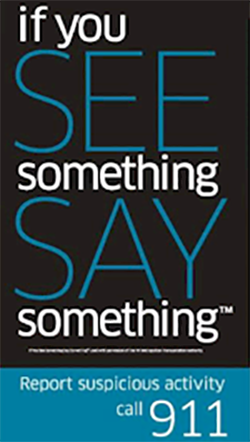Bike Safety
Use the following links (below) to view our bicycle safety information...
______________
______________
View the short video ...
Bicycle Safety Tips for Adults (8 min video) …
Three essential pieces of equipment:
1) A properly fitted bicycle helmet is the single most effective
piece of safety equipment you can use, regardless of your
age or skill level.
Wear a quality, properly fitted helmet, and adjust it
before every wide.
*If you’re buying a new helmet, make sure it’s CPSC-certified.
If you are using an older helmet, make sure it is SNELL or ANSI
Approved.
2) If you are riding at night, or in low light conditions, you need lights
and reflectors. It’s not just a good idea – it’s the law.
Every state requires bicyclists to have a white front light and a red rear light or reflector on the back of their bike.
3) You want to be seen and recognized by motorists at any time
of day so wear bright clothing or reflective tape or markings.
To help insure a safe and fun ride, do the
A-B-C-Quick Check before you ride …
A is for Air. Check that your tires are properly inflated. Low pressure tires can easily puncture.
B is for Brakes. Check that your brakes are working. Your brake levers shouldn’t come closer than a thumb’s-width from the handle bar and your wheels should spin freely when the brakes are off.
C is for the Cranks, Chain, and Cassette. Grab both crank-arms and wiggle them to make sure they aren’t loose. Spin the pedals and make sure the chain runs smoothly through the gears.
QUICK is for the Quick-Release Levers (if you have them). Make sure they’re on tight if you have quick-release wheels. The wheels should be snug in the dropouts and the release-lever “tight”.
Finally, check and make sure nothing else is loose on your bike. If there’s anything you can’t fix, take your bike to a local bike shop and get a professional to help you.
Have a good ride! -- But remember … bicyclists have the same rights and responsibilities as motor vehicle operators, so we follow the same rules of the road.
Remember some basic rules:
1. Ride in the same direction as traffic. Bicyclists riding the wrong way can cause a crash for two reasons.
Know how to “drive your bike” in traffic. The same rules of the road apply to bikes and cars in most states. Turning motorists, in particular, are not looking for you there – and you can’t see the traffic signs or signals if you’re heading the wrong way.
2. Obey All Traffic Signs, Signals and Road Markings. This means stopping at stop signs and red lights and yielding to crossing pedestrians.
It also means, riding in turn lanes when you turn, and riding in straight lanes when you’re going straight.
3. Ride Defensively. Look before riding out of driveways and sidewalk crossings. Always look out for pedestrians in your path. Look behind you before changing lanes.
4. Know The Law. Laws differ in each state and jurisdiction. In some areas it’s illegal to ride your bicycle on the sidewalk. If you must ride on the sidewalk, look for turning and passing vehicles at driveways and intersections.
Every community has different rules and regulations for driving a bicycle. Know those that apply to you, obey those, and set a good example for others.
5. Avoid Road Hazards. Carefully ride around drain grates, gravel, glass and debris.
6. Be Predictable. Help motorists know exactly what you plan to do. Signal, make eye contact if you can, and ride without swerving. Signaling and checking behind you while riding straight takes practice, so working on these skills in a vacant lot is a smart idea.
Stay to the right and pass on the left. This applies to the road and on a shared-use path or trail. On a path, give an audible signal and always yield to pedestrians and people on horseback. When trails cross roadways, use caution and obey and traffic signs and signals.
Bike safely and have fun!
______________
Other bike safety videos …
NHTSA’s Bike Safe, Bike Smart video
(Targeting parents and younger viewers. – Excellent for parents to watch with their children.)
AAA’s Bike Safety - What it Means to Be a "Roll" Model
AAA’s Bike Safety – Sharing the Road
AAA’s Bike Safety – Safe Cycling Tips for Adults
____________________________
Remember: Know the law. View Bicycles and Oklahoma Law



